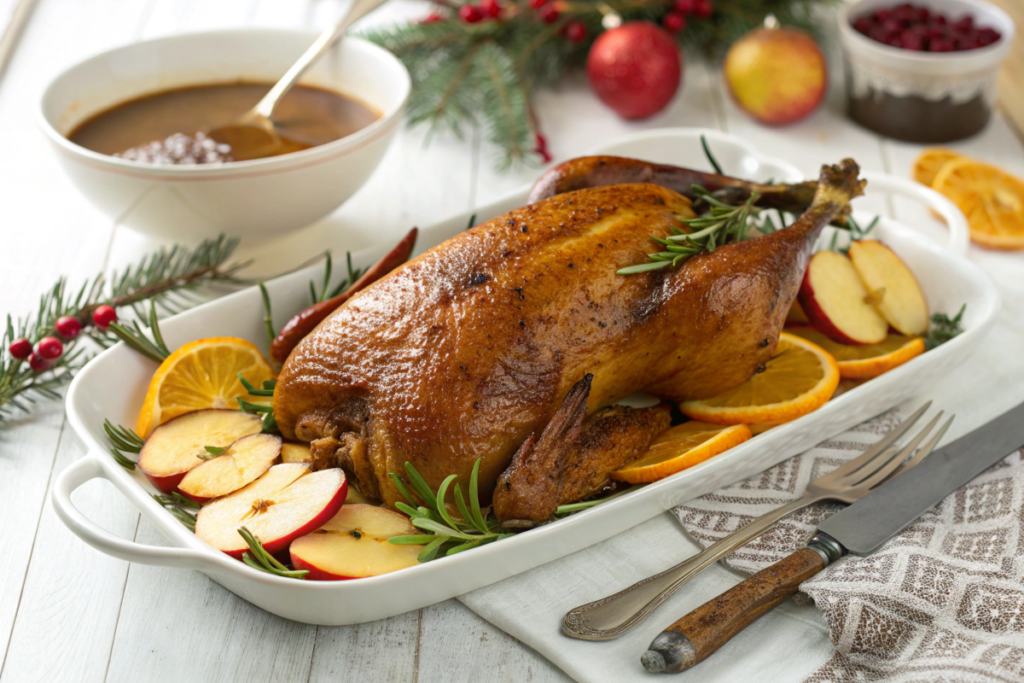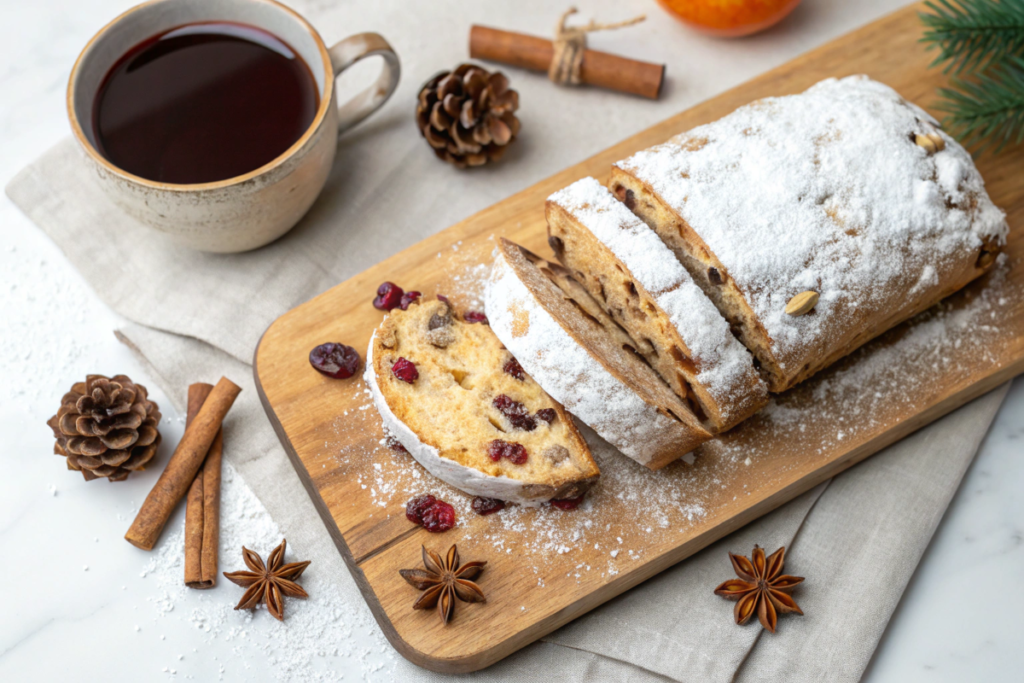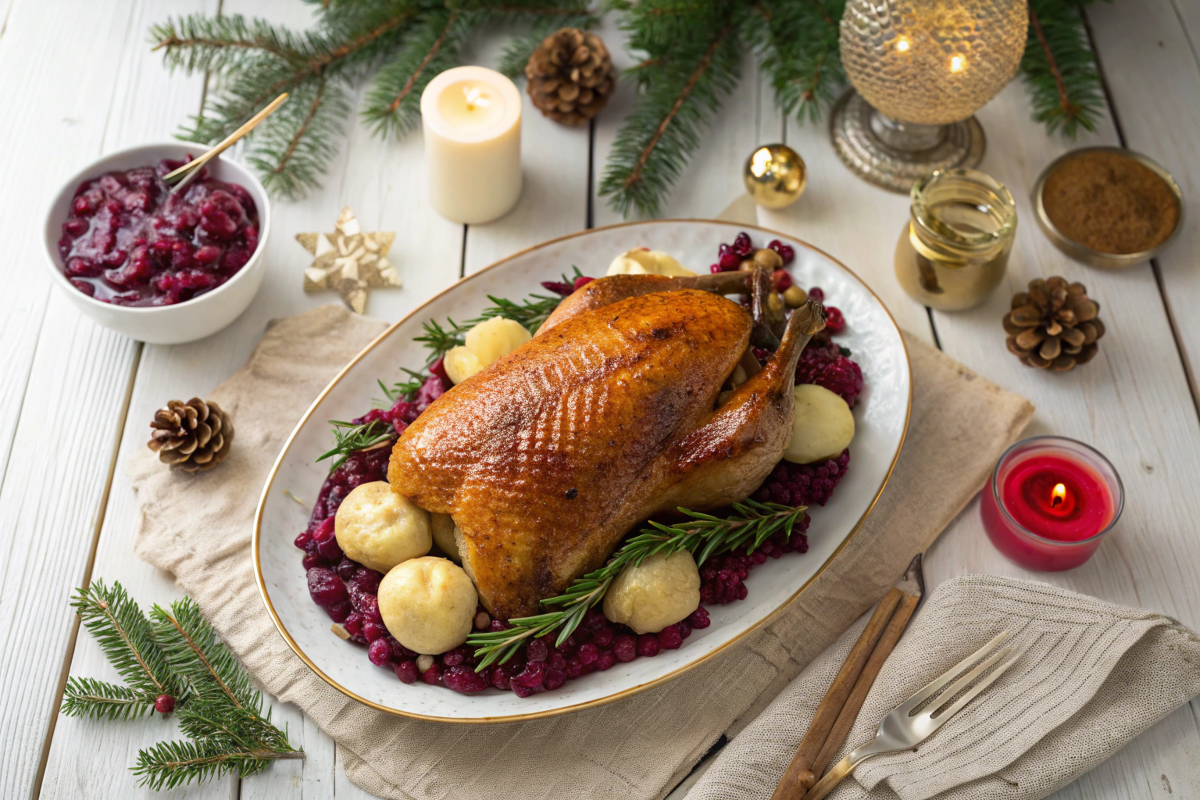Introduction to German Christmas Traditions
What is a typical German Christmas dinner? It’s a celebration of warmth, family, and treasured customs that bring everyone together. From festive markets to delicious meals, the holiday season in Germany is filled with traditions passed down through generations. A significant part of this celebration is the Christmas dinner, which features hearty dishes and sweet treats. For a closer look at how holiday desserts compare around the world, explore this guide on what Americans eat for dessert at Christmas.
Significance of Christmas Dinner in Germany
The Christmas dinner plays a central role in German holiday celebrations. Families come together on Christmas Eve or Christmas Day to enjoy a special meal that symbolizes unity and gratitude. Traditional dishes often include roast goose or duck, sausages, red cabbage, and potato dumplings.
Desserts like stollen (a fruit bread with marzipan), lebkuchen (spiced cookies), and gingerbread add sweetness to the occasion. These meals not only showcase Germany’s rich culinary traditions but also emphasize the joy of spending quality time with loved ones.
Regional Variations in Christmas Feasts
Germany’s diverse regions influence its Christmas dinner traditions, offering a variety of flavors and specialties.
- Bavaria: This region serves dishes like roast pork, pretzels, and sauerkraut, reflecting its hearty cuisine.
- Saxony: Known for buttery desserts, Saxony delights with its famous stollen and spiced pastries.
- Northern Germany: Fish dishes, such as carp or herring salad, are popular due to the region’s proximity to the sea.
- The Rhineland: Sauerbraten (marinated pot roast) takes center stage, often accompanied by red cabbage and dumplings.
Each region highlights unique culinary customs, making Christmas dinners distinct and memorable.
German Christmas traditions, especially the festive meals, celebrate family, food, and cultural heritage. Whether enjoying regional dishes or timeless classics, these feasts bring meaning and joy to the holiday season.
Key Elements of a Traditional German Christmas Dinner
A traditional German Christmas dinner is more than just a meal—it is a time to connect with family and celebrate the joy of the season. Rooted in customs and filled with delicious dishes, this special gathering reflects Germany’s rich holiday traditions.
The Role of Family and Gathering
Family plays a central role in German Christmas dinners. These meals are an opportunity for loved ones to come together, share stories, and enjoy a festive atmosphere. Unlike casual meals, the Christmas dinner carries a sense of formality and tradition. Families often begin the evening by lighting candles on the Advent wreath or singing carols together.
The meal itself fosters a feeling of closeness. Sharing hearty dishes like roast goose, sausages, or red cabbage strengthens bonds and creates lasting memories. By focusing on togetherness, the Christmas dinner becomes the heart of the holiday celebration.
Timing of the Christmas Dinner
In Germany, the timing of the Christmas dinner depends on family traditions. Many families enjoy their main holiday meal on Christmas Eve after attending church services or opening gifts. This evening meal sets the tone for the festivities that follow.
For others, the main dinner takes place on Christmas Day or even on the second day of Christmas (Boxing Day). Regardless of the day, the meal is always prepared with care and attention to detail. This thoughtful timing allows families to savor the experience without rushing, making the holiday even more meaningful.
A traditional German Christmas dinner is not just about the food—it is about family, tradition, and the joy of being together. Whether held on Christmas Eve or Christmas Day, it remains a cherished part of Germany’s holiday celebrations.
Traditional German Christmas Dishes
Christmas in Germany is a time for delicious, hearty meals that bring families together. At the center of the holiday table, a perfectly roasted goose or duck often takes the spotlight. This cherished tradition reflects both historical roots and a love for flavorful, celebratory dishes.
Goose or Duck as the Centerpiece
History of Roasted Goose or Duck on Christmas
The tradition of serving goose or duck at Christmas dates back to the Middle Ages. Goose was initially favored for festive meals, especially in farming communities, because it was a common poultry option after the harvest season. Its rich flavor and ability to feed a large group made it ideal for special occasions. Over time, duck also gained popularity as an alternative, offering a slightly milder taste and similar celebratory appeal.
In many households, the roasted bird became a symbol of abundance and gratitude, particularly during the holiday season. This custom remains a beloved part of German Christmas celebrations today.
Preparation Techniques and Recipes
Preparing a traditional roasted goose or duck requires care and attention to detail.
- Seasoning: The bird is typically seasoned with a blend of salt, pepper, garlic, and herbs like thyme or rosemary. This enhances its natural flavor.
- Stuffing: Traditional stuffing often includes apples, onions, chestnuts, and sometimes prunes, adding sweetness and depth to the dish.
- Roasting: The bird is roasted at a moderate temperature to ensure crispy skin and juicy meat. Basting with its own juices during cooking helps maintain moisture and flavor.
- Serving: The roasted goose or duck is often served with sides like red cabbage (Rotkohl), potato dumplings (Kartoffelknödel), and a rich gravy made from the drippings.
A roasted goose or duck as the centerpiece of a German Christmas dinner is more than just a meal—it is a tradition steeped in history and full of flavor.
Potato Dumplings (Kartoffelknödel)
Variations and Pairing with Other Dishes
Kartoffelknödel (potato dumplings) are a beloved side dish at German Christmas dinners. These soft, round dumplings are made from either boiled potatoes, raw potatoes, or a combination of both, resulting in slight regional variations.
- Classic Variations:
- Boiled Potato Dumplings: These are smooth and fluffy, offering a delicate texture that pairs well with rich sauces.
- Raw Potato Dumplings: These have a firmer texture and a slightly earthy flavor.
- Stuffed Dumplings: Some versions include fillings like croutons, herbs, or bacon for added flavor.
- Pairings:
Potato dumplings are typically served with hearty main dishes like roast goose, duck, or sauerbraten. Their absorbent texture makes them perfect for soaking up flavorful gravies and sauces, enhancing the overall meal.
Red Cabbage (Rotkohl)
Sweet and Sour Flavor Profile
Rotkohl (red cabbage) is a classic German side dish that balances the richness of the main course with its sweet and tangy flavors. The dish is prepared by slow-cooking shredded red cabbage with ingredients like vinegar, sugar, apples, and spices such as cloves or bay leaves.
- Sweetness: The addition of apples and sugar creates a gentle sweetness that complements the cabbage’s natural earthiness.
- Tanginess: Vinegar provides a subtle sour note, which gives the dish its signature balance.
The result is a flavorful and aromatic side that feels both light and satisfying.
How It Complements the Main Course
Red cabbage pairs beautifully with traditional German Christmas dishes.
- Contrast: The sweet and tangy notes of Rotkohl cut through the richness of roasted meats like goose or duck.
- Color and Texture: Its vibrant purple hue adds visual appeal to the plate, while its soft texture contrasts nicely with crispy or hearty elements of the meal.
- Versatility: Rotkohl works well with other sides like potato dumplings and gravy, bringing harmony to the overall flavor profile.
Together, Kartoffelknödel and Rotkohl are essential components of a traditional German Christmas dinner. Their complementary flavors and textures enhance the main course, creating a well-rounded and memorable holiday meal.
Gravy and Sauces
Importance of Rich Gravy
A rich and flavorful gravy is essential to any traditional German Christmas dinner. It ties together the main course and sides, enhancing every bite with depth and warmth. The savory taste of gravy complements roasted meats like goose or duck while adding moisture and richness to potato dumplings and red cabbage.
- Flavor Enhancement: Gravy made from pan drippings captures the essence of the roast, making it an irreplaceable element of the meal.
- Texture Balance: Its smooth consistency contrasts with crispy meats and hearty sides, creating a harmonious dining experience.
In German Christmas traditions, a well-prepared gravy is not just a sauce—it is the foundation that elevates the meal.
Recipes for Authentic German Sauces
Authentic German gravies and sauces are prepared with care, using simple but flavorful ingredients.
- Classic Brown Gravy (Bratensauce):
- Ingredients: Pan drippings, beef or vegetable broth, flour, butter, and optional wine or beer.
- Preparation: Deglaze the roasting pan with broth or wine, whisk in flour or starch for thickening, and simmer until the gravy reaches the desired consistency.
- Serving Tip: Pour generously over roasted meats and potato dumplings for maximum flavor.
- Apple Sauce:
- Ingredients: Apples, sugar, cinnamon, and a splash of lemon juice.
- Preparation: Cook apples with sugar and spices until soft, then mash or blend to a smooth consistency.
- Serving Tip: Apple sauce pairs beautifully with roasted duck or pork, offering a sweet contrast.
- Cream Sauce (Rahmsauce):
- Ingredients: Butter, cream, flour, and chicken or vegetable broth.
- Preparation: Combine butter and flour to create a roux, then slowly add broth and cream, whisking until smooth.
- Serving Tip: Use this sauce to accompany lighter dishes or as a variation to traditional gravy.
These sauces add flavor, texture, and a touch of tradition to a German Christmas dinner, making the meal unforgettable.
Gravies and sauces play a vital role in German holiday meals, bringing depth and balance to every dish. Whether you prefer the robust flavor of brown gravy or the sweetness of apple sauce, these recipes ensure your Christmas dinner feels complete.

Side Dishes and Accompaniments
Side dishes are an essential part of a traditional German Christmas dinner, adding flavor, texture, and variety to the meal. Whether it’s dumplings, sauerkraut, or roasted vegetables, these accompaniments perfectly complement the main courses and bring balance to the festive table.
Bread Dumplings (Semmelknödel)
Semmelknödel, or bread dumplings, are a popular and hearty side dish often served with rich gravies and roasted meats. Made from day-old bread, eggs, milk, and seasonings, these dumplings are soft, flavorful, and satisfying.
- Why They’re Popular: They are an excellent way to soak up sauces, making them a perfect pairing for dishes like roast duck or goose.
- Preparation Tip: Add fresh parsley or nutmeg to the dough for extra flavor, and boil the dumplings until they are tender and fluffy.
Sauerkraut and Its Role in Festive Meals
Sauerkraut, made from fermented cabbage, holds a special place in German holiday meals. Its tangy and slightly salty flavor provides a delightful contrast to rich, roasted meats.
- Traditional Pairings: Sauerkraut is often served with sausages, pork, or even alongside roasted goose.
- Why It’s Essential: The acidity of sauerkraut helps balance the richness of the meal while offering a distinctively German taste.
- Serving Tip: Slow-cook sauerkraut with bacon, onions, or apples to add depth and sweetness to the dish.
Roasted Vegetables with a German Twist
Roasted vegetables add color and nutrition to the Christmas table while complementing the heartier dishes. A German twist on this classic side dish often includes seasonal produce and traditional spices.
- Vegetable Choices: Popular options include carrots, parsnips, brussels sprouts, and potatoes.
- Flavor Enhancements: Roast the vegetables with butter, garlic, thyme, and a sprinkle of caraway seeds for an authentic German touch.
- Why They’re a Hit: Their roasted sweetness balances the savory flavors of the main course, making them a versatile and crowd-pleasing side dish.
These side dishes and accompaniments play a crucial role in creating a well-rounded and satisfying German Christmas dinner. Whether it’s the hearty bread dumplings, tangy sauerkraut, or roasted vegetables, these additions ensure every bite is filled with flavor and holiday cheer.
German Christmas Desserts
German Christmas desserts are known for their rich flavors and festive appeal. From the iconic stollen to spiced cookies and marzipan creations, these sweet treats bring tradition and joy to the holiday season.
Stollen – The Iconic Christmas Bread
Ingredients and Preparation
Stollen is a fruit-filled bread that symbolizes German Christmas traditions. Its rich and slightly dense texture, combined with sweet dried fruits and nuts, makes it a festive favorite.
- Key Ingredients: Flour, butter, yeast, milk, dried fruits (raisins, currants), candied orange peel, almonds, and marzipan. A dusting of powdered sugar gives it a snowy appearance.
- Preparation: The dough is enriched with butter and kneaded with dried fruits and nuts. Some variations include a marzipan filling for added sweetness. After baking, the stollen is coated with melted butter and powdered sugar to lock in moisture and flavor.
- Serving Tip: Slice and serve with a cup of coffee or tea for the perfect holiday treat.
Lebkuchen – German Christmas Cookies
Spices and Techniques
Lebkuchen, often referred to as German gingerbread, is a spiced cookie that embodies the flavors of the season. Soft and chewy, it is sometimes glazed or coated in chocolate for extra indulgence.
- Key Spices: Cinnamon, nutmeg, cloves, cardamom, and ginger. These spices create the signature warm and aromatic flavor.
- Techniques: The dough is rolled out and shaped into rounds or festive designs. After baking, the cookies are glazed with sugar syrup or dipped in dark chocolate.
- Serving Tip: Pair with mulled wine (Glühwein) or hot cocoa for a cozy holiday experience.
Marzipan and Its Use in Christmas Treats
Marzipan, made from ground almonds and sugar, is a versatile ingredient in German Christmas desserts. Its sweet, nutty flavor makes it a beloved component of many holiday treats.
- Uses in Desserts:
- Marzipan Figures: Shaped into festive forms like animals, fruits, or Christmas decorations.
- Stollen Filling: Adds a creamy, sweet surprise when used as a filling in stollen.
- Marzipan Candy: Often dipped in chocolate for a simple yet indulgent treat.
- Why It’s Popular: Marzipan’s smooth texture and almond flavor make it a standout ingredient in traditional German sweets.
German Christmas desserts like stollen, lebkuchen, and marzipan treats capture the essence of the holiday season. Their unique flavors and rich history make them an essential part of festive celebrations, bringing warmth and sweetness to Christmas tables.

FAQs About Typical German Christmas Dinner
Can vegetarian or vegan options replace traditional dishes?
Yes, dishes like stuffed cabbage rolls or vegetable roasts can be delicious alternatives.
What is the history of roasted goose in German Christmas feasts?
It dates back to the Middle Ages, symbolizing abundance and often served during festive celebrations.
Are there specific drinks paired with German Christmas meals?
Yes, mulled wine (Glühwein), beer, or Riesling wine are common pairings with holiday dishes.
Conclusion
The timeless appeal of German Christmas dinners lies in their ability to bring family and tradition together. From hearty main courses to sweet desserts, each dish tells a story of heritage and celebration. By embracing these traditions, you not only honor the past but also create lasting memories that make the holiday season truly special. Whether it’s a roasted goose, kartoffelknödel, or a slice of stollen, these meals remind us of the joy found in togetherness and the magic of Christmas.

